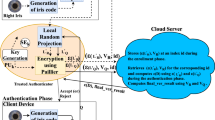Abstract
Iris recognition is one of the important authentication mechanisms; authentication needs verification of individuals for uniqueness hence converting iris data into barcode is an appropriate in authenticating individuals to identify uniqueness. Such converted barcode is unique for every iris image. In iris recognition, most applications capture the eye image; extract the iris features and stores into the database in digitized form. The size of the digitized form is equal to or little less than original iris image. This as leads to the drawbacks such as more usage of memory and more time required for searching and matching operations. To overcome these drawbacks we propose an approach wherein we convert extracted iris features into barcodes. This transformation of iris into barcode reduces the space for storage and the time required for searching and matching operations, which are essential features in real time applications.















Similar content being viewed by others
References
Al-Raisi AN, Al-Khouri AM (2008) Iris recognition and the challenge of homeland and border control security in UAE. Telematics Inform 25(2):117–132
Andrew L, Robb H (1995) Two dimensional data encoding structure and symbology for use with optical fibres, United States Patent, Patent Number: 5591956, May 15
Canny J (1986) A computational approach to edge detection. In: Pattern analysis and machine intelligence, IEEE transactions, vol 6, pp 679–698
Chanda B, Mujumder DD (2011) Digital image processing and analysis EEE, 2nd edn, PHI Learning Private Limited, Delhi
Czajka A, Strzelczyk P, Chochowski M, Pacut A (2007) Iris recognition with match-on-card. In: 15th European Signal Processing Conference, September 2007, Pozman, pp 189–192
Jain AK, Ross A, Prabhakar S (2004) An introduction to biometric recognition. IEEE Trans Circuits Syst Video Technol 14(1):4–20
Kong WK, Zhang D (2001) Accurate iris segmentation based on novel reflection and eyelash detection model. In: Proceedings of IEEE international symposium on Intelligent multimedia, video and speech processing 2001, pp 263–266
Kulkarni SB, Hegadi RS, Kulkarni UP (2011). Improvement to libor Masek algorithm of template matching method for iris recognition. In: Proceedings of the International Conference and Workshop on Emerging Trends in Technology, ACM pp 1270–1274
Masek L, Kovesi P (2003). Matlab source code for a biometric identification system based on iris patterns, vol 2(4) The School of Computer Science and Software Engineering, The University of Western Australia
Miyazawa K, Ito K, Aoki T, Kobayashi K, Nakajima H (2006) A phase-based iris recognition algorithm. In: Advances in biometrics: international conference, ICB 2006, Hong Kong, China, January 5–7, proceedings. Springer, New York Inc, p 356
Rathgeb C, Uhl A (2010) Secure iris recognition based on local intensity variations. In: Proceedings of the 7th international conference on image analysis and recognition, vol (Part II). Springer, Berlin, pp 266–275
Sanchez-Avila C, Sanchez-Reillo R (2005) Two different approaches for iris recognition using Gabor filters and multiscale zero-crossing representation. Pattern Recognit 38(2):231–240
Schuckers SA, Schmid NA, Abhyankar A, Dorairaj V, Boyce CK, Hornak LA (2007) On techniques for angle compensation in nonideal iris recognition. IEEE Trans Syst Man Cybern Part B Cybern 37(5):1176–1190
Sylvester (2001) J Reed Solomon Codes
Tang RN, Han JQ, Zhang XM (2009) Efficient iris segmentation method with support vector domain description. Optica Appl 39(2):365
Vatsa M, Singh R, Noore A (2008) Improving iris recognition performance using segmentation, quality enhancement, match score fusion, and indexing. IEEE Trans Syst Man Cybern Part B Cybern 38(4):1021–1035
Voke J (1999) Radiation effects on the eye. Part 3b. Ocular effects of ultraviolet radiation. Optom Today 1999:37–40
Wildes R, Asmuth J Green G Hsu S, Kolczynski R, Matey J, McBride S (1994) A system for automated iris recognition. In: Proceedings IEEE workshop on applications of computer vision, Sarasota, pp 121–128
Acknowledgments
The authors wish to thank CASIA and AICTE. “Portions of the research in this paper use the CASIA-IrisV3 collected by the Chinese Academy of Sciences’ Institute of Automation (CASIA)” and a reference to “CASIA-IrisV3, http://www.cbsr.ia.ac.cn/IrisDatabase.htm”. The work is partially supported by the Research Grant from AICTE, Govt. of India, Reference No: 8023/RID/RPS-114(PVT)/2011-12 Dated December, 24-2011.
Author information
Authors and Affiliations
Corresponding author
Appendix 1
Appendix 1
Aztec Symbols mapping value table

Rights and permissions
About this article
Cite this article
Kulkarni, S.B., Hegadi, R.S. & Kulkarni, U.P. Iris data encryption based on Aztec Symbology. Evolving Systems 4, 203–217 (2013). https://doi.org/10.1007/s12530-013-9075-8
Received:
Accepted:
Published:
Issue Date:
DOI: https://doi.org/10.1007/s12530-013-9075-8




